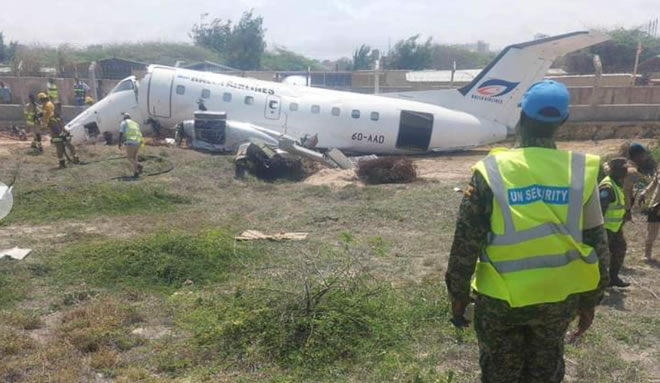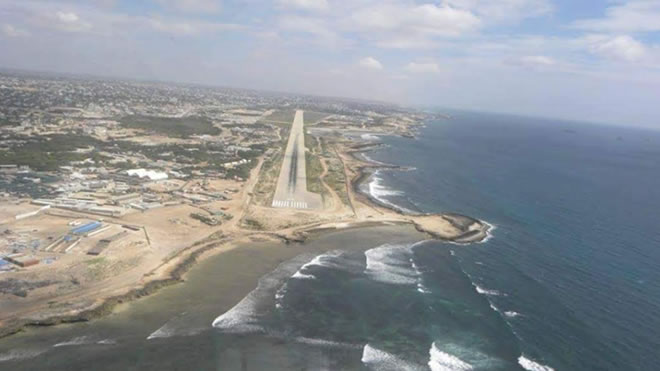by Dr. Ibrahim Abikar Noor
Friday July 14, 2023

Halla Airlines plane that veered off the runway during landing at Aden Adde International Airport
Within a year short of one week, 2 airplanes crash landed on Runway 05 at Aden Adde International Airport, Mogadishu. The first accident occurred on July 18, 2022 and the second crash was on July 11,2023. Miraculously, there were no fatalities involved despite the first plane crashed, cater wheeled, rolled on its back then caught fire; while the second aircraft careened off the runway after landing, smashed into a concrete block, and the cockpit separated from fuselage.
This
writing looks at few types of airplane landings and weather conditions that
could pose challenges. I will then offer recommendations and end with a concluding
thought. However, before going deeper into my writing, a short disclaimer is in
order. This article is not based on investigations of the crashes or statements
from the crew of those airplanes, but on reflections of this author’s personal
experience flying in and out of Aden Adde International for a decade as well general
concept of flying.
Takeoff
and landing are the most critical phase of flight operation. In takeoff, thrust
is maximum where fuel consumption is much higher than when the plane is at cruising
altitude. During takeoff, pilots are on high alert to the possibility of engine
failure which can be fatal if corrective action is not taken immediately.
Similarly, pilots are very much focused on keeping the aircraft aligned on the
runway and maintain correct glide path during landing.
Having
watched the videos of crashes at Aden Adde international, both planes landed on
Runway 05. Aden Adde International has one runway with 05 and 23 designation.
To my non-aviator friends, the numbers represent runway magnetic degree which is
compass heading corrected for deviation. For example, if wind is coming from
north heading south, pilots fly parallel close to the coast to land to north-runway
05. Conversely if there is southerly wind at the airport, pilots use runway 23.
In other words, fly over the city and land toward the sea touching down by the Somali
Airforce camp-Aviazione.

Runway 05. Aden Adde International Airport, Mogadishu
Coming
in for landing or taking off, pilots need to know the wind direction and speed.
This information is given to them by the ground controller or tower. To naked
eye, the first crash seemed to have landed the beginning edge of the runway, and
immediately after, one of the main landing gears collapsed. The second crash
also landed very close to beginning of the runway, and like the first accident,
a main landing gear collapsed. Both planes were using runway 05. From this we
can elucidate the wind direction given to the cockpit crew was a northerly wind
direction. With that background, here are few points to ponder:
50
feet over runway threshold.
Pilots
need to cross runway threshold at 50 feet high. Threshold is the beginning of
the runway and is clearly marked with several long parallel lines visible to
pilots when they are close to landing (see the photo above). Additionally,
big jets have radio altimeter that reads out loud when the plane is coming in
for landing. A voice prompt reads and one thousand, five hundred, one hundred, and
fifty feet. The airplane should be crossing the threshold when the radio
altimeter voice prompt sounds “Fifty”- meaning fifty feet high. Granted small aircrats
are not equipped like big airplanes, pilots need to plan to go over threshold at
or close to 50ft altitude.
Over
obstacle approach, Short field and crosswind landing.
The
landing phase is one of the most difficult maneuver pilots undergo during
initial training since all landings are not the same. The training covers how
to approach the runway when there is high train or obstacle close to the runway
threshold. Precautions are taken to stay clear of barriers. Training manual almost
always cover short field landing. In this case, 50 feet over threshold does not
apply since the runway is short. Landing can be aimed at the beginning of the
runway to ensure enough runway distance is available for the plane to stop.
Mogadishu runway is long enough for most planes. Thus, no need to execute short
field landing technique.
Crosswind
landing is another exercise that is part of student training. This
phenomenon is when wind is blowing from side angle to the runway instead of
head-on making difficult to align the airplane on the runway centerline. Each
airplane has a designated maximum crosswind speed where pilots are expected to
go to alternate runway, or to another airport if crosswind maximum is over the particular
aircraft’s specification. Such is the case with Mogadishu in high crosswind
speed situation because of the single runway.
Windshear
This
is a weather condition where wind suddenly changes direction and speed. Low
altitude windshear is usually caused by thunderstorms or obstacles-including
constructions-in the vicinity of the runway. Windshear can push the airplane
vertical (up or down), or sideways, and is dangerous during landing as the airplane
is close to the ground. Airport controller, tower, or other pilots advise
approaching airplanes of this dangerous weather condition.
Recommendations
The
aim of this writing is to shed light on challenges cockpit crew experience during
landing. The 2 crashes in 2022 and 2023 on runway 05 at Aden Adde international
should serve as a) lessons learned, and b) an opportunity for improvement. Here
are few points that could contribute to the safety of flight operations. This
suggestion is more catered toward the landing phase.
- Runway lights such as Visual Approach Slope
Indicator (VASI), and Precision Approach Path Indicator (PAPI) are set of lights
that orient pilots during landing. PAPI, are four lights located on the
left side of the runway. These lights inform pilots whether their approach
is high (4 white lights), low (4 red lights), or on correct glide path (2
white and the rest 2 red). See diagram below.
- Another tool widely used in main
airports-including our neighboring countries-is Instrument Landing System
(ILS). This is a precision radio navigation system on the field that helps
pilots maintain correct vertical and horizontal path toward the runway.
Most airplanes are equipped with ILS instrument that receives the radio
signal to help maintain correct glide path. ILS is extremely important
during low visibility and night time. (See diagram below).
- Acquiring modern Meteorological equipment is
important to help inform pilots of mother nature dangers such as
windshear, turbulence, thunderstorm at enroute and approach, and crosswind
strength.
- Consistent, well-put staff and leadership trainings
are equally important to maintain employees current on technology use,
aviation policies, communication, evaluative thinking, and information
sharing endeavors.
For
an old airport with limited space to possibly build another runway albeit
increasing flight operations, resource alignment is necessary for Aden Adde
international to meet the demand and stay competitive. In less than a year, a combined
70 souls onboard were involved in the crashes of Fokker 50 and Embraer 120. This
could be a national security crisis in the making if current trend holds. It
needs to be addressed as such using competent manpower and cutting-edge technology.
Looking into the different funding streams of the country’s civil aviation
industry, and more appropriations from government’s general fund (if any) could
be one revenue source to help with shortcomings. Additionally, engaging private
sector for the common good is equally important. The Somali aviation industry
has seen tremendous improvement in recent years as evidenced by the increasing
airline companies interested to start operations at Aden Adde International.
Yet more is needed in safety and quality. Above all, is there a nominal dollar
value on human lives?
Dr.
Ibrahim Abikar Noor
Former
Somali Airline pilot
[email protected]